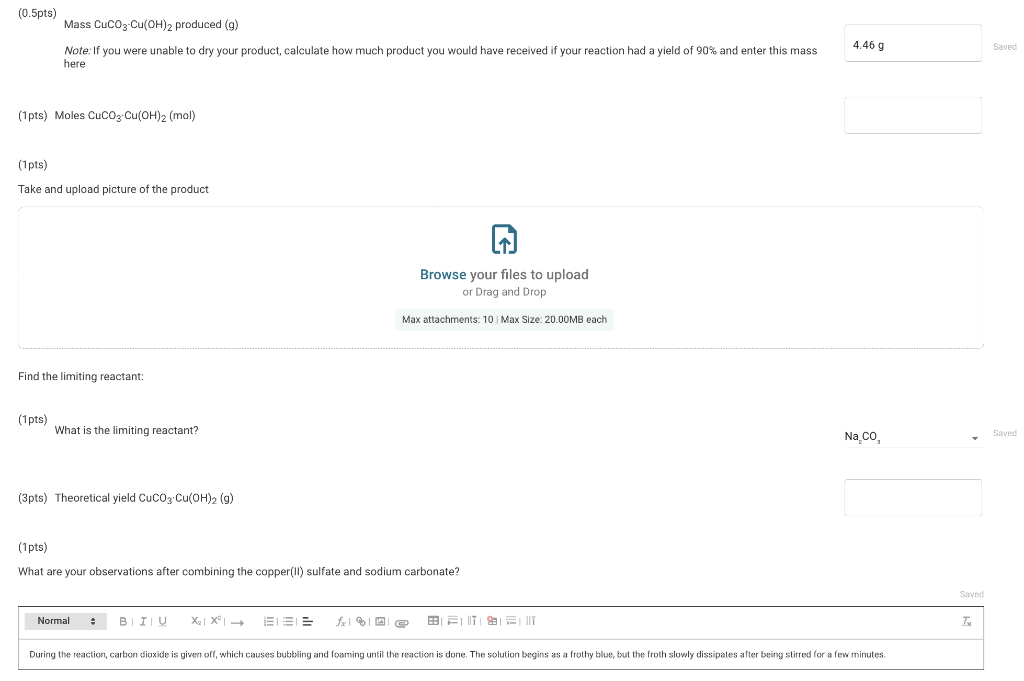





(16pts) Part 1: Synthesis of Malachite (0.5pts)MassCuSO45H2O(g) (1pts) Moles CuSO45H2O (mol) (2pts) What is the colour of copper(il) sulfate solution? (0.5pts) Volume of DI water that CuSO45H2O was dissolved in (mL) (1pts) What is the molarity of the solution you made when dissolving CuSO45H2O in water? (0.5pts) Volume of 10%Na2CO3 solution ( mL ) (1pts) Moles Na2CO3 (mol) The percent concentration by mass is defined as massofsolutionmlassofsolute100%. Using the volume of 10%Na2CO3 measured in the lab, find the number of moles of Na2CO3 (0.5pts) Mass CuCO3Cu(OH)2 produced (g) Note: If you were unable to dry your product, calculate how much product you would have received if your reaction had a yield of 90% and enter this mass here (1pts) Moles CuCO3Cu(OH)2(mol) (1pts) Take and upload picture of the product Browse your files to upload or Drag and Drop Name all chemical changes for this reaction. (1pts) Identify the type of this reaction. (23pts) Part 2: Making Verdigris, Coppe (0.5pts) Mass CuSO45H2O(g) (1pts) Moles CuSO45H2O(mol) (2pts) What is the colour of copper(II) hydroxide solution? (0.5pts) Mass Cu(CH3COO)2(g) Note: If you were unable to dry your product, calculate how much product you would have received if your reaction had a yield of 75% for the entire process of converting CuSO45H2O to verdigris and enter this mass here (1pts) Moles Cu(CH3COO)2 (mol) (1pts) What is the excess reactant? Assuming that from 1mol of CuSO45H2O1mol of verdigris is formed, find the theoretical and percent yields of the pigment. (3pts) Theoretical yield Cu(CH3COO)2(g) (2pts) Percent yield Cu(CH3COO)2(%) (1pts) Identify the type of this reaction. (1pts) Why is it particularly important to wash the cupric hydroxide intermediate in the synthesis of cupric acetate (verdigris)? Be specific about what is being removed and wh (1pts) How many moles are present in 4.2mL of 2.0MNaOH ? (mol) Could blue copper sulfate pentahydrate be used as a pigment for making paint? Why? (1pts) Give the chemical equation for the decomposition of copper(II) hydroxide. (1pts) In old times, the verdigris was made by exposing copper plates to the acetic acid vapours. This process is called an "artificial degradation'. Similar degradation takes place when a copper object is exposed to the natural environment over time. A thin layer of blue-green colour, patina, forms on the surface of this object. What are the most commonly found degradation products/minerals in copper objects? You may need to do some research to answer this question. (3pts) Explain why does malachite have a blue-green colour? What wavelengths of light does it absorb? What did you observe when mixing the two solutions to make Malachite that did not happen when you made Verdigris? In the synthesis of malachite, when the two solutions are mixed, CO2 is made, which is shown by the bubbling, but this does not happen in the syn (1pts) What feature is shared by the formulas of coloured compounds used as pigments? (16pts) Part 1: Synthesis of Malachite (0.5pts)MassCuSO45H2O(g) (1pts) Moles CuSO45H2O (mol) (2pts) What is the colour of copper(il) sulfate solution? (0.5pts) Volume of DI water that CuSO45H2O was dissolved in (mL) (1pts) What is the molarity of the solution you made when dissolving CuSO45H2O in water? (0.5pts) Volume of 10%Na2CO3 solution ( mL ) (1pts) Moles Na2CO3 (mol) The percent concentration by mass is defined as massofsolutionmlassofsolute100%. Using the volume of 10%Na2CO3 measured in the lab, find the number of moles of Na2CO3 (0.5pts) Mass CuCO3Cu(OH)2 produced (g) Note: If you were unable to dry your product, calculate how much product you would have received if your reaction had a yield of 90% and enter this mass here (1pts) Moles CuCO3Cu(OH)2(mol) (1pts) Take and upload picture of the product Browse your files to upload or Drag and Drop Name all chemical changes for this reaction. (1pts) Identify the type of this reaction. (23pts) Part 2: Making Verdigris, Coppe (0.5pts) Mass CuSO45H2O(g) (1pts) Moles CuSO45H2O(mol) (2pts) What is the colour of copper(II) hydroxide solution? (0.5pts) Mass Cu(CH3COO)2(g) Note: If you were unable to dry your product, calculate how much product you would have received if your reaction had a yield of 75% for the entire process of converting CuSO45H2O to verdigris and enter this mass here (1pts) Moles Cu(CH3COO)2 (mol) (1pts) What is the excess reactant? Assuming that from 1mol of CuSO45H2O1mol of verdigris is formed, find the theoretical and percent yields of the pigment. (3pts) Theoretical yield Cu(CH3COO)2(g) (2pts) Percent yield Cu(CH3COO)2(%) (1pts) Identify the type of this reaction. (1pts) Why is it particularly important to wash the cupric hydroxide intermediate in the synthesis of cupric acetate (verdigris)? Be specific about what is being removed and wh (1pts) How many moles are present in 4.2mL of 2.0MNaOH ? (mol) Could blue copper sulfate pentahydrate be used as a pigment for making paint? Why? (1pts) Give the chemical equation for the decomposition of copper(II) hydroxide. (1pts) In old times, the verdigris was made by exposing copper plates to the acetic acid vapours. This process is called an "artificial degradation'. Similar degradation takes place when a copper object is exposed to the natural environment over time. A thin layer of blue-green colour, patina, forms on the surface of this object. What are the most commonly found degradation products/minerals in copper objects? You may need to do some research to answer this question. (3pts) Explain why does malachite have a blue-green colour? What wavelengths of light does it absorb? What did you observe when mixing the two solutions to make Malachite that did not happen when you made Verdigris? In the synthesis of malachite, when the two solutions are mixed, CO2 is made, which is shown by the bubbling, but this does not happen in the syn (1pts) What feature is shared by the formulas of coloured compounds used as pigments












